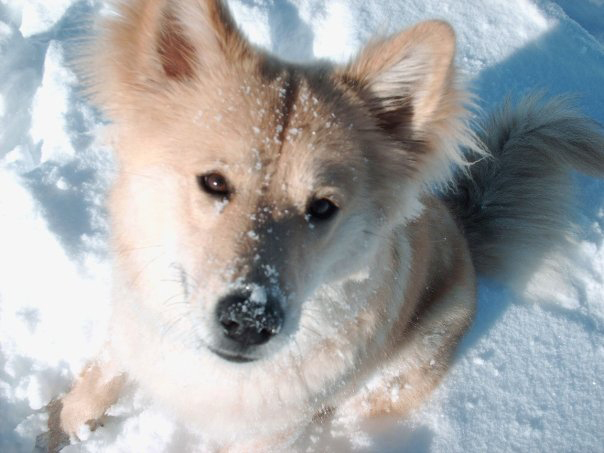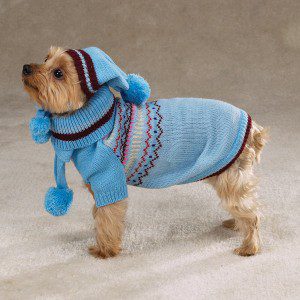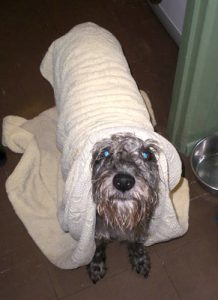Duty Free Pets Pooper Scooper Service is a professional Colorado pooper scooper / dog poop removal company. Our goal is to create a healthy and safe environment for you and your fur friends.
One way we do this is through our ongoing dog safety blog. Like us on Facebook and share this article with you family and friends.
10 Winter Time Dog Safety Tips
 Like the weather outside a dogs health needs change for the season. This article is designed to provide you with some winter dog tips and tricks to keep your fur kid healthy and safe in the winter season.
Like the weather outside a dogs health needs change for the season. This article is designed to provide you with some winter dog tips and tricks to keep your fur kid healthy and safe in the winter season.
Please join the discussion and let others know your personal experience with the subject as you might help save a dogs life.
1 – Winter Dog Vet Check
Many dog lovers will choose to take their dogs for a vet visit before the cold seasons really set in. This gives your doctor the ability to check for health issues that could be affected by the the colder winter months. Older dogs are particularly prone to the adverse winter conditions.
During this visit make sure you talk to your vet about your fur kid’s diet. Some dogs need more protein to help keep them warm in the cold winter months and this is a perfect time to ask the vet if your dog is one of ’em. While your at the vet’s get well stocked on any medications your dog needs. You should always keep a 5 day supply of pet meds on hand just in case you cannot venture out to get restocked for a few days.
2 – Keep Your Pets Inside
We are never an advocate for exposing your dogs to weather for a duration of time that you yourself wouldn’t want or couldn’t possibly be exposed to. If you do take your dog outside or for walks when the mercury drops remember this rule of thumb. If you are cold enough to have to go inside, chances are they are too.
If you ever do need to leave your dogs outside for a long period of time make sure they have warm solid shelter from the winds, thick bedding, and plenty of NON-FROZEN water. As a pooper scooper service we constantly see frozen water in the back yard for dogs. You can by heated water bowls for dogs and we strongly recommend them.
A couple tricks to keep your dog warm is to fill a hot water bottle (with hot water) and wrap it in a towel (to not burn your dog) and let them cuddle with it. You may also use a sock filled with dry rice that has been heated in the microwave.
Remember, dogs are very resourceful animals with a drive for life. When in search of the warmth of shelter dogs can dig into and collapse snowbanks, hide under porches, window wells, dumpsters, cellars, and occasionally get trapped or caught up on things.
Car trips can be deceptive. Most of us know the dangers of hot cars to pets. However, cold cars can be just as life threatening. Your car can rapidly become like an icebox for your pet. Do not leave your dogs in unattended vehicles for long periods of time even in the winter. If you do have to leave your dog in the car make sure they have the appropriate bedding or heat source for the duration you will be away.
3 – Safe Heat
 Have your furnace checked or have a carbon monoxide detector on hand. Carbon monoxide is invisible and odorless and you want to make sure to avoid exposure to high levels for you and your pets. Dogs usually spend more time in the casa than their human companions making them more vulnerable to monoxide poisoning. Problems can range from fatigue, headaches, and even death!
Have your furnace checked or have a carbon monoxide detector on hand. Carbon monoxide is invisible and odorless and you want to make sure to avoid exposure to high levels for you and your pets. Dogs usually spend more time in the casa than their human companions making them more vulnerable to monoxide poisoning. Problems can range from fatigue, headaches, and even death!
If you have a fireplace or use a space heater to heat your home keep this in mind. If a baby can get to it chances are your dog can too. The biggest difference is we tend to leave our dogs more unsupervised than children. Yet they have the same tendencies to knock things over or get into trouble. Child proof your heat sources so your dog doesn’t knock it over or start a fire that would destroy your home and possibly kill them.
4 – The Clothing Option
 Not all dogs require clothing to go out in cold weather. Many dogs are bred for these conditions like Saint Bernards, Huskies, Chows and many other breeds. However, if your dog has a short coat or is bothered by cold weather you might want to think about a dog sweater or even dog booties.
Not all dogs require clothing to go out in cold weather. Many dogs are bred for these conditions like Saint Bernards, Huskies, Chows and many other breeds. However, if your dog has a short coat or is bothered by cold weather you might want to think about a dog sweater or even dog booties.
When buying a sweater for your dog always make sure it fits properly. Over sized sweater can get your dog hung up on things and a small fitting sweater can cut off circulation or limit range of motion. Have several sweaters on hand and make sure EVERY TIME your dog goes out that the sweater is not damp or wet. Just like when we put on something wet this can actually make a dog colder than wearing nothing at all. If you are looking for the best heating options look for ones with a high collar that covers from the base of the tail to neck including the belly works the best. Struttin’ Pup in Lafayette Colorado has a great selection!
5 – Signs of Problems
There are several signs that your dog is too cold and has developed hypothermia. These include shivering, whining, movement slows down, seems anxious, stops moving, appears weak or starts to burrow. If you suspect your dog has developed hypothermia get them inside immediately, wrap them in warm blankets, dry them, massage their fur, and call your veterinarian immediately!
Frostbite is harder to detect on dogs. The results generally appear a few days later. Frostbite occurs when tissue is damaged because of exposure to 32 degrees F and below temperatures. The tissue damage can be superficial or major depending on the length of time that your dog is exposed. Follow this link for a more in depth article about How to identify and treat frostbite in dogs.
Do not allow snow to pack into a dogs paws. If you have a dog with longer hair and snow gets caught between their paws you run a risk of cracking the pads. When this starts to happen it is very painful for your dog and they will often just stop walking. Remember any further walking could severely damage your dogs pads.
If your dog does have a problem with snow collecting in their pads here are a few suggestions. Have your groomer or you clip away some of the hair, have your dogs wear booties, or some people will massage their dogs paws with olive oil. All three of these methods will help.
7 – Avoid Frozen Bodies of Water
If your dog is exposed to frozen lakes, ponds or creeks be very cautious about letting your dog off leash to explore. Dogs are not exposed to ice too often so their instincts might not be the best or not even know they are on weak ice that could break through. If a dog does go through the ice it is very difficult for them to escape on their own.
I know if my dogs went into the frozen water I would have a hard time not going in after them. However this could be the death of both of you. If you have to go into a frozen body of water after your dog make sure you have a means to escape and someone is there with you.
8 – Wipe ’em Down
 If you walk your dogs in urban areas there is a high chance of exposing them to salt, antifreeze, road deicers, and other potentially dangerous chemicals while licking clean from a walk. Once your dog is inside make sure to wipe any excess moisture that is on them to reduce the amount of toxins they digest while cleaning themselves after a walk. Especially their paws, legs, and belly. If you know that where you walked had these contaminates it is always safer to wash down these areas with water.
If you walk your dogs in urban areas there is a high chance of exposing them to salt, antifreeze, road deicers, and other potentially dangerous chemicals while licking clean from a walk. Once your dog is inside make sure to wipe any excess moisture that is on them to reduce the amount of toxins they digest while cleaning themselves after a walk. Especially their paws, legs, and belly. If you know that where you walked had these contaminates it is always safer to wash down these areas with water.
9 – Don’t Let Them Roam
When snow and rain covers an area your dog can loose their most valuable resource, their sense of smell. Once a dog looses their sense of smell they can become easily lost. More dogs are lost in the winter months than any other season. Keep your dog safe especially when exploring unfamiliar areas, keep them on a leash.
10 – Tag and Chip Your Dog
Make sure your fur kids are tagged and chipped. This way if they do become lost it greatly increases their chance to be returned to you. Always make sure the tag and chip information are up to date!
Colorado winters can be breathtakingly beautiful, but they also bring frigid temperatures and snowstorms that can pose risks to our furry friends. As responsible pet owners, it’s crucial to prioritize our dogs’ safety and well-being during the winter months. In this blog, we’ll share ten invaluable tips to help keep your beloved canine companions safe, happy, and healthy in the snowy wonderland of Colorado.
#1 #BundleUpYourBuddy: Just like humans, dogs feel the cold, too. Invest in a cozy and well-fitted doggie jacket or sweater to help your furry friend stay warm during walks and outdoor activities.
#2 #PawProtection: Salt and de-icing chemicals used on sidewalks and roads can be harmful to your dog’s paws. Consider using pet-friendly paw balms or booties to protect their delicate paw pads from ice, chemicals, and freezing temperatures.
#3 #StayActiveIndoors: On days when the weather is too harsh, create indoor playtime routines or engage in mentally stimulating activities like puzzle toys and obedience training to keep your dog mentally and physically active.
#4 #SuperviseOutdoorTime: When letting your dog out in the yard, always keep a close eye on them. Dogs can get disoriented in heavy snowfall or lose their scent trails, potentially leading to dangerous situations. Ensure your yard is secure and free from hazards.
#5 #LeashSafety: During winter walks, keep your dog on a leash, even if they are well-trained. Snow can mask familiar scents, making it easy for them to become lost or disoriented. A sturdy leash and a properly fitting collar or harness are essential.
#6 #WatchForFrostbite: Frostbite can affect dogs just as it does humans. Keep an eye out for signs such as pale or gray skin, cold or hard areas, or blisters. Pay extra attention to vulnerable areas like ears, tails, and paws. If you suspect frostbite, seek immediate veterinary care.
#7 #AvoidIceMeltChemicals: Avoid walking your dog on surfaces treated with ice melt chemicals. These substances can be toxic if ingested and cause irritation if they come into contact with the skin or paws. Choose pet-friendly alternatives or rinse their paws after each walk.
#8 #HydrationMatters: Cold weather can be dehydrating for dogs, so ensure they have access to fresh water at all times. Consider using heated bowls or regularly replacing the water to prevent it from freezing.
#9 #KnowYourLimits: Not all dogs are built for extreme cold. Small, short-haired, or elderly dogs may have lower tolerance levels. Monitor your dog’s behavior closely and limit their time outdoors if necessary.
#10 #StayVisible: During winter, visibility can be reduced due to early sunsets and snowfall. Attach reflective or LED accessories to your dog’s collar, harness, or jacket to make them more visible during walks and prevent accidents.
Conclusion: Colorado winters offer countless opportunities for joyous adventures with our canine companions. By following these ten essential dog winter safety tips, you can ensure that your furry friend stays protected, healthy, and happy throughout the colder months. Remember, a little extra care goes a long way in safeguarding your four-legged family member against the elements. Stay safe, stay warm, and enjoy the wonders of winter with your furry friend by your side!
#DogSafetyTips #WinterWoofers #ColoradoCanines #ColdWeatherCautions #FurryFriendSafety #PawProtection #BundleUpYourBuddy #IndoorPlaytime #WinterWalks #FrostbiteAwareness

